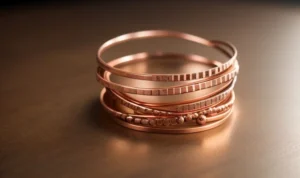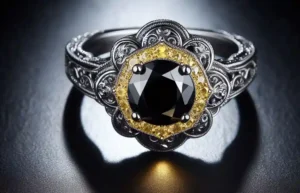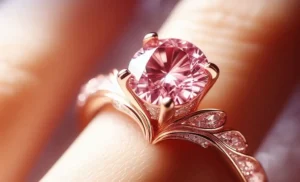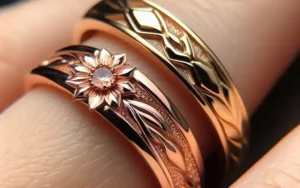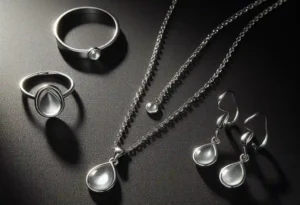Can Black Tourmaline Go in Water? In the world of crystal healing and gemstone collection, black tourmaline stands out for its supposed protective properties and its sleek, dark allure.
However, as enthusiasts delve deeper into the care and keeping of their precious stones, a common question arises: Can black tourmaline go in water?
In this blog post, we’ll explore the compatibility of black tourmaline with water, scrutinize its physical composition, and offer insights into the safest methods for cleansing and caring for this powerful gem.
Can Black Tourmaline Go in Water?

Yes, black tourmaline can go in water, but with caution. While this mineral’s physical composition affords it a certain level of durability that can withstand brief and infrequent water contact, it’s important to be mindful of the risks involved.
The presence of microscopic fractures within the stone, although not immediately compromising its structure, can become channels for water entry. Over time, this may lead to internal damage or exacerbate existing imperfections, especially with prolonged or repeated water exposure.
Moreover, while black tourmaline’s chemical stability means it won’t dissolve upon contact with water, the interaction with chemicals commonly found in tap water, such as chlorine, could potentially affect the stone’s surface and integrity.
Therefore, while it’s technically safe for black tourmaline to have minimal contact with water, adopting a cautious approach by limiting exposure and opting for alternative cleansing methods when possible, is advised to ensure the longevity and preservation of the stone’s physical and energetic properties.
Understanding the Physical Composition of Black Tourmaline
Black tourmaline, scientifically referred to as schorl, is distinguished by its rich, iron-based composition, contributing to its characteristic deep black coloration. This mineral is part of a broader family of borosilicate minerals, known for their complex structure and significant presence of iron among other elements.
Its physical form is typically elongated and cylindrical, with noticeable striations that run parallel along its length, a feature that not only defines its aesthetic but also its structural attributes.
This stone’s intriguing composition makes it notably resistant to abrasions, a property owed to the tightly packed molecular structure inherent in borosilicate minerals.
The iron content, while imparting the black tourmaline’s opaque darkness, also plays a role in its overall density and hardness, which are significant factors in its resilience against physical damage. It is this robustness that lends black tourmaline the ability to withstand brief water contact without immediate adverse effects.
However, it’s pertinent to note that despite its durability, the mineral is not impervious to all forms of damage. Inherent in its structure are natural imperfections and fractures, a commonality among crystalline minerals.
These microscopic flaws, though not undermining the stone’s beauty or immediate structural integrity, do suggest a susceptibility to external forces, including water, under certain conditions.
Such characteristics underscore the importance of a balanced approach to handling and care, especially concerning water exposure, to maintain the stone’s physical condition and by extension, its aesthetic appeal.
The General Rule of Thumb for Crystals and Water
Navigating the waters of crystal care requires an understanding of each stone’s unique properties and susceptibilities. A foundational aspect to consider is the Mohs hardness scale, which grades minerals on their ability to withstand scratches.
Generally, those rated 6 or higher are deemed more resistant to the effects of water, making them less prone to physical damage from brief immersions. However, this metric is just one part of a broader picture.
Crystals, including those with higher hardness ratings, may still possess vulnerabilities that aren’t captured by this scale. For instance, some minerals might be soluble in water or react chemically with common substances found in tap water, like chlorine and fluoride.
Additionally, the existence of pre-existing microfractures within a crystal can be exacerbated by water, which may lead to structural weakening over time.
Therefore, while the Mohs scale provides a helpful preliminary guideline, it’s crucial to delve deeper into each crystal’s specific characteristics and historical context. Understanding the full scope of a stone’s relationship with water—including chemical composition, solubility, and typical internal structures—offers a more nuanced approach to care.
This comprehensive perspective ensures that while certain crystals can safely meet water for short periods, the broader implications of such interactions are always taken into account, fostering a more informed and cautious approach to crystal maintenance.
The Potential Risks of Water Exposure for Black Tourmaline
While a brief rinse under water may seem harmless for black tourmaline, it’s important to recognize the latent risks associated with prolonged exposure. One of the more immediate concerns is the exacerbation of microfracture.
These small, often invisible cracks can absorb water, which may lead to significant structural weakening or even breakage over time. Additionally, tap water typically contains chemicals like chlorine, which could potentially react with the surface of the stone, altering its appearance and possibly its purported energetic qualities.
There’s also the risk of water stripping the stone of its natural oils, leading to a loss of luster. This can make the stone appear dull and less vibrant, detracting from its aesthetic appeal. While black tourmaline is known for its durability, these potential risks underscore the need for careful consideration when deciding to expose the stone to water.
It is particularly crucial for collectors and practitioners who value not only the physical but also the metaphysical aspects of their stones to be mindful of these factors. Indirect damage, such as the impact on metal settings in jewelry pieces, should also be considered, as prolonged water exposure can weaken these components, leading to a higher risk of loss or damage to the stone.
How to Safely Cleanse Black Tourmaline with Water
To properly and safely cleanse your black tourmaline using water, meticulous attention is required to prevent any inadvertent damage to the stone. Begin by selecting distilled or purified water, which is devoid of the harsh chemicals found in tap water, such as chlorine and fluoride, that can potentially harm the stone’s surface. It’s crucial that the water is at room temperature to avoid thermal shock, which can exacerbate any existing microfractures within the crystal.
When cleansing, gently immerse the black tourmaline in the water for a brief moment — a quick dip is all that’s needed. Avoid any vigorous scrubbing or soaking, as prolonged contact with water can lead to the issues previously discussed, such as the expansion of microfractures or a dulling of the stone’s natural luster.
After removing the stone from the water, carefully pat it dry with a soft, lint-free cloth to remove any moisture. Ensuring the stone is thoroughly dried is vital to prevent any water from being trapped in crevices, which could lead to damage over time.
This process should be employed sparingly, only when you feel your black tourmaline needs a physical cleanse in addition to the energy clearing methods recommended. By adhering to these guidelines, you can cleanse your stone without compromising its physical structure or its energetic qualities.
Water-Compatible Alternatives for Cleansing Black Tourmaline
For enthusiasts seeking methods to cleanse black tourmaline without the risk of water exposure, several effective alternatives exist. Smudging, a traditional practice involving the burning of sage or palo santo, can purify the stone by surrounding it with smoke, believed to clear negative energies. This method is gentle on the stone and preserves both its physical and energetic integrity.
Another approach involves placing the black tourmaline on a bed of sea salt, which is thought to draw out impurities and negativity from the stone. The salt acts as a natural purifier without physically touching the crystal, making it an ideal choice for those cautious about damaging their stones.
Exposing black tourmaline to moonlight is another popular, non-invasive method. Placing the stone under the light of a full moon can recharge its energies, providing a cleanse that is as effective energetically as it is safe physically. This method is especially favored for its simplicity and the natural alignment with lunar energies, which many believe enhances the stone’s properties.
Lastly, burying black tourmaline in the earth for a short period allows the soil to absorb and neutralize any negative energies harbored within the stone. This method connects the stone back to its natural origins, revitalizing its energy in a profound, grounding manner.
These alternatives offer safe and effective ways to maintain the purity of black tourmaline, ensuring its longevity both as a physical object and as a conduit for protective and grounding energies.
The Final Verdict: Can Black Tourmaline Go in Water?
Navigating the care of black tourmaline in relation to water exposure necessitates a balance between understanding its inherent durability and recognizing the subtleties of its potential vulnerabilities.
While this mineral’s Mohs hardness rating supports brief, infrequent contact with water without immediate detriment, a deeper appreciation for its intricate composition underscores the advisability of caution.
Factors such as the presence of microscopic fractures and the potential chemical interactions with common tap water additives highlight the complexity of water exposure, beyond mere physical resilience.
It’s imperative to approach the cleansing or charging of black tourmaline with a nuanced perspective, considering both its robustness against simple mechanical damage and the broader context of its long-term care. Opting for water as a cleansing medium should be a considered decision, weighed against the availability of alternative methods that mitigate the risks associated with water interaction.
These alternatives not only serve to preserve the stone’s physical integrity but also respect its metaphysical aspects, offering pathways to maintain its vibrancy without unnecessary exposure to potential harm.
Thus, while water may not be an outright adversary to black tourmaline, the decision to introduce these elements to one another should be informed by a comprehensive understanding of the stone’s nature and an intentional care strategy that prioritizes its preservation.
Frequently Asked Questions About Black Tourmaline and Water
1. Is it safe to submerge black tourmaline in water for cleansing?
While black tourmaline can withstand brief immersions in water without dissolving, it’s advisable to exercise caution. Frequent or prolonged water exposure can lead to structural weaknesses due to the expansion of microscopic fractures, and potentially alter the stone’s appearance by reacting with chemicals in tap water.
2. Can I shower with my black tourmaline jewelry on?
It is recommended to remove black tourmaline jewelry before showering. The combination of hot water, soap, and potential chemicals in your shower water can accelerate wear and tear on both the stone and its settings, risking damage over time.
3. What is the recommended frequency for cleansing black tourmaline with water?
To preserve the integrity and appearance of black tourmaline, limit water cleansing to instances where it’s absolutely necessary. Opt for gentler, alternative cleansing methods that do not involve water for routine care and maintenance.
4. Does water cleansing impact the metaphysical properties of black tourmaline?
Beliefs on how water affects the energy of black tourmaline vary. While some hold that water can purify the stone energetically, others worry it could disrupt its natural vibrations.

















